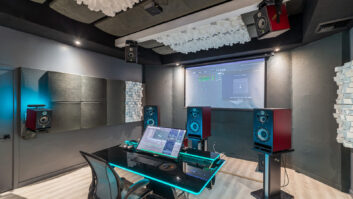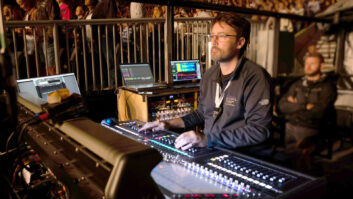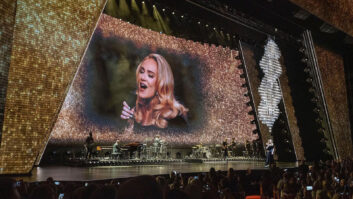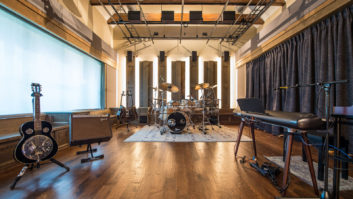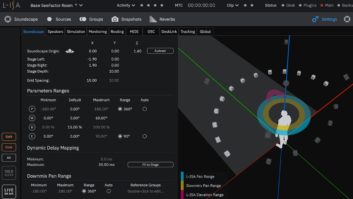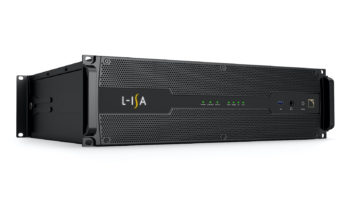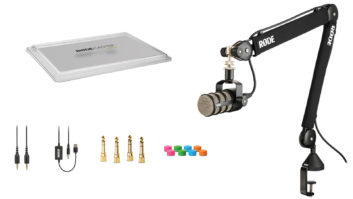Las Vegas, NV—The electronic dance music (EDM) scene has exploded in Las Vegas over the past decade as the city’s resorts have launched nightclubs and then dayclubs to capitalize on the buzz created by UK DJ Paul Oakenfold’s yearlong residency at Palms Casino Resort beginning in the fall of 2008. Now, the world’s highest-paid DJs are in town every week, the Electric Daisy Carnival annually attracts 400,000-plus revelers and contributes millions of dollars to the Las Vegas economy, and the city has a brand-new, three-room music mixing and mastering facility catering almost exclusively to EDM.
Studio DMI (Digital Music Innovation) is by no means a new venture, having previously occupied a modest space at Wynn Las Vegas that was home to three-time Grammy-nominated mixing and mastering engineer Luca Pretolesi. Moving to the new multiroom complex, located several miles west of the Las Vegas Strip, has allowed the team to expand, providing separate rooms for mixing and mastering engineers Scotty Banks (Studio D) and Andy Lin (Studio M, a multipurpose room), in addition to Pretolesi’s Studio I.
Related:
– Mixing Lower Frequencies at Electric Daisy Carnival, by Kelleigh Welch, June 19, 2019
– Rave Comes of Age, by Steve Harvey, May 22, 2014

The new facility came together in partnership with manufacturer Focal Naim America, which also distributes the custom Zaor studio furniture and Vicoustic acoustic treatments found throughout the complex. “When we find tools and individuals that we want to work with, that we feel we’re in sync with and that we have a vibe with, and we are authentically fans of their work, a relationship can come from that,” says company co-founder, CEO and president Ronnie F. Lee.
Pretolesi, with whom Lee has worked for 28 years, initially as a musician, outfitted the previous studio with Focal SM9 monitors. “Focal took note of the fact that we were exposing their speakers to a pretty fantastic circle of artists,” including Skrillex, Diplo and Jermaine Dupri, Lee says. “When we were going to expand and increase the size of our facility, they were a natural partner to reach out to. Dangerous Music was similar; it was a matter of admiring the equipment, using it, liking it and then creating a relationship.”
Studios D and I both feature Focal’s new Trio11 Be midfield monitors paired with a single Sub6, together with Focal Shape 40 compact nearfields. Studio M offers a pair of Trio6 Be speakers. According to Pretolesi, the Trio11 Be offers precise, detailed separation of the mix elements at any volume without introducing fatigue during long hours of mixing, though he notes favoring the Shape 40s when focusing on vocals and reverbs.
DJs, producers and artists seek out Pretolesi for the signature sound that he brings to their projects using a collection of outboard hardware refined over the years. Some EDM producers simply need their mixes elevated with his mastering, while others give him free rein to get creative with the mixing, he says, so his setup occupies the sweet spot between the two approaches.
Each bay of his Zaor console respectively houses processing for the drum bus, stereo bus and final stage. “We’re not reinventing the workflow based on every mix,” says Pretolesi. “It’s a way to retain the same workflow with the same gear and add a similar tone, but customize it based on the needs of the track.”

The console includes gear from Bettermaker, Dolby, Maselec and others, but every mix begins with the Dangerous Convert-Plus, where Pretolesi introduces the clipping that has become part of his signature sound, plus the initial compression and EQ into which he always mixes. “It sounds complicated, but the initial portion of the mix is crucial for the final result for me; it’s like 50 percent of the mix is already done,” he says.
On his Dangerous Compressor, he elaborates, sidechain EQ only passes information between 700 Hz, sometimes 1 kHz, and 5 kHz or 6 kHz. “I use it to bring the midrange to the front of the mix and do less in the box to try to compress and bring low-level information up in the midrange,” he says. Using the Dangerous Liaison analog patch unit, he can put the Dangerous Compressor before or after a heavily modified SSL bus compressor clone, he adds.
One of his secret weapons is a unique equalizer designed and manufactured for Studio DMI by 82-year-old Livio Argentini, founder of pro audio hardware company Audio Line and a former engineer at Italy’s national broadcaster, RAI. “I think Livio is the Rupert Neve of Italy,” Pretolesi says. The one-of-a-kind unit boasts features including mid-side EQ, custom-wound transformers and solo on individual EQ bands. “It’s the tone-shaping EQ of the stereo bus for my mixes, an initial stage of EQ rather than the final stage of mastering.”

Banks, who shared the same gear at the Wynn while working with Pretolesi, has a similar approach to his mentor but a very different setup. “My workflow has gone back to being mostly in the box,” says Banks, whose clients include Stray Kids, Baby K, Alok and Luan Santana. There is some hardware in his room, including mic preamps and an Eventide H3000, but it’s mostly for vocal sessions in the adjacent booth.
Like Pretolesi, Banks works in PreSonus’ Studio 1 DAW, and has devised a workflow that mimics his former analog outboard chain. “I love Lime from Acustica Audio, and El Rey, which is one of the plug-ins that we did with Acustica,” he says.
Studio DMI has worked with Acustica on several Diamond series plug-ins, beginning with the Color EQ a couple of years ago. “That plug-in is as close as possible to what Luca is able to get on his masters,” he says, referring to the end product sampled part of Pretolesi’s EQ chain. “The top end can be very aggressive, but it’s very musical and shimmery.”
Next was Lift, which emulates elements of Pretolesi’s EQ, sidechaining, compression and converter clipping. “It creates an idea of our workflow. You’re able to get the sound that we’re able to achieve without having $30,000 of gear,” says Banks.
Related: Producer Greg Wells Talks Inside Abbey Road Sessions, by Larry Jaffee, Aug. 12, 2013

More recently, Studio DMI worked with engineer Greg Wells to sample his favorite tube compressor for the El Rey plug-in. “It’s transparent, but you can have it be very colorful if you want. It’s very gluey and pulls everything together.”
A Dangerous Liaison provides patching to a Dangerous Compressor and a Bax EQ, as well as an FCS P3S compressor. “If I want a little analog vibe, I do have that option,” says Banks, who, like Pretolesi, sends tracks via the Convert-Plus transformers to add excitement and color.
Outside Studio DMI, the team has participated in educational workshops at Sweetwater and the NAMM Show and around the world, in China, France, Holland and Italy, Lee reports, but the new, expanded facility is expected to bring more clients to Vegas to work there, continuing the facility’s mission. “We’ve been sharing and trying to facilitate people’s desires to make good music,” he says.
Studio DMI • studiodmi.com
